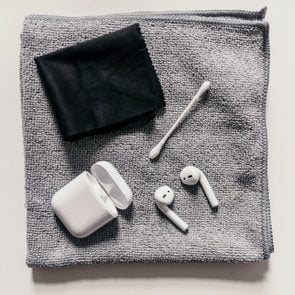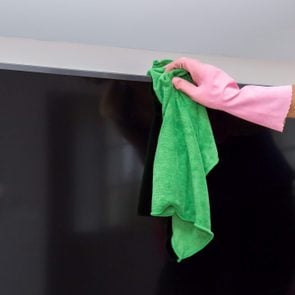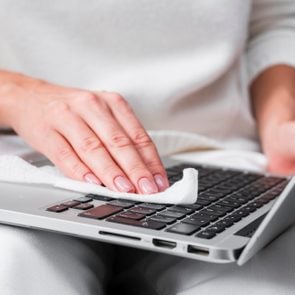How to Clean Your Cell Phone—and How Often You Should
Updated: Apr. 18, 2024
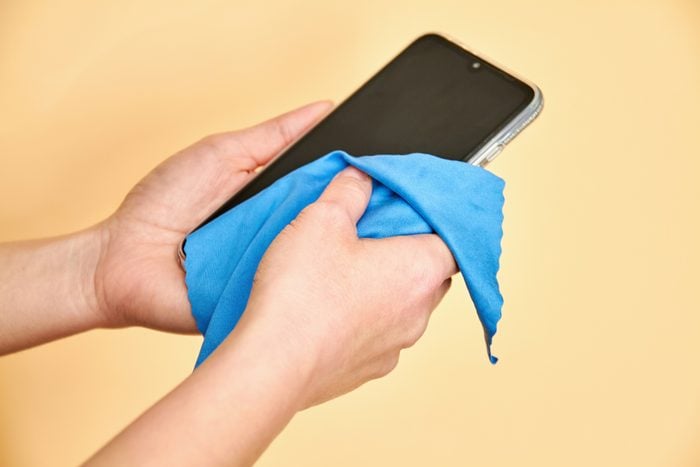
Your phone is grosser than you realize. Wondering how to clean a phone without damaging it? Follow the experts' step-by-step instructions.
Get this: Your smartphone is dirtier than a toilet seat. Sure, many of the germs found on your phone could be harmless. But in a study published in 2023, researchers found that a whopping 92% of cell phones carried illness-causing bacteria like strep and E. coli. If you’re anything like us, that fact alone makes a good case for learning how to clean your phone screen or how to clean iPhone charging port—and making it a regular part of your cleaning schedule.
If you want to be extra thorough at removing germs and bacteria from your smartphone, you’re in the right place. We asked microbiologist Charles Gerba, PhD, and cleaning expert Jessica Ek to share the scoop on how to properly disinfect your iPhone or Android, which products you should use, how often you should clean your device and more.
So grab your phone and crank up the cleaning tunes because you’re about to perfect the art of removing germs and bacteria from your trusty device.
Get Reader’s Digest’s Read Up newsletter for more cleaning, humor, travel, tech and fun facts all week long.
About the experts
Reviewed for accuracy by: Burton Kelso, owner of tech-repair company Integral and a technology expert with more than 30 years of experience working with all types of tech devices and gadgets. |
How to clean a phone screen at home
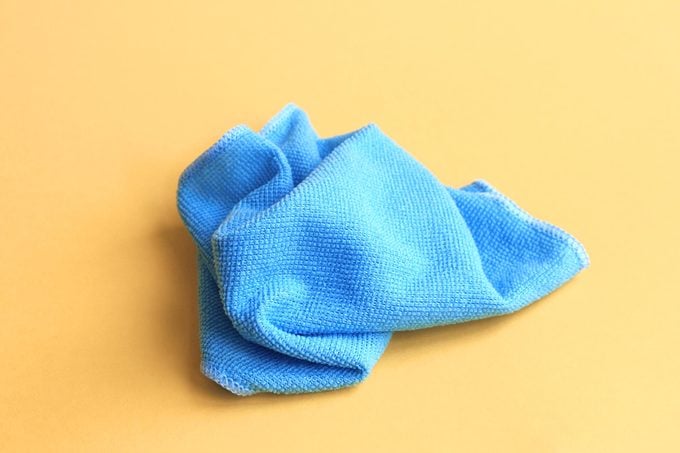
As a microbiologist, Gerba knows just how germy phones can be (read: very, very germy), so he recommends at least daily cleanings. Some experts even recommend cleaning it every time you return home. Luckily, the process is quick, and you can use a simple item you probably already have at home. Read on to find out how to clean your phone screen of bacteria and other germs.
Supplies you’ll need
- Microfiber cloth
Directions
- Power down your smartphone.
- Remove your phone’s case. Germs can get caught in the corners of the case, so it’s important to take it off when cleaning, says Ek.
- If you have a screen protector that is pulling up on the sides or at the corners, remove it and throw it away. Bacteria can build up there too, according to Ek.
- Gently wipe your screen with a microfiber cloth.
- Don’t forget to clean the camera’s lenses and edges with a microfiber cloth. A sign yours needs cleaning? Your pictures will start to come out blurry.
How to disinfect a phone
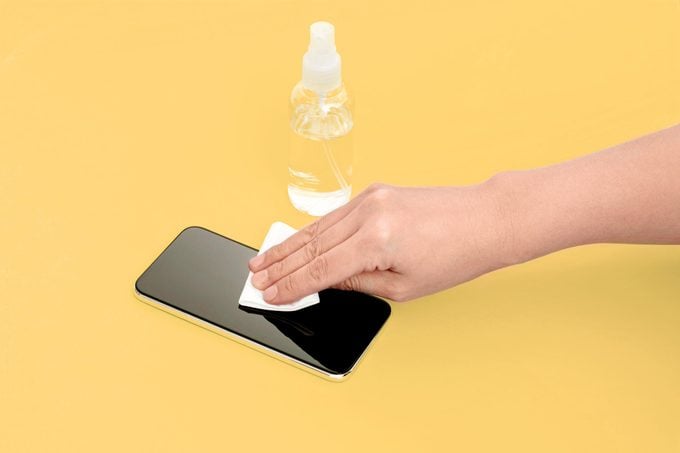
The average smartphone screen carries more than 10,000 types of bacteria, so you need to go beyond daily wipe-downs. You may be tempted to use disinfectant wipes on your phone, but not so fast! You want to avoid those at all costs. According to Burton Kelso, owner of Integral computer services and a technology expert with more than 30 years of experience working with all types of tech devices and gadgets, the harsh chemicals in these wipes can ruin your phone’s screen and digitizers.
The good news: You don’t need a fancy phone sanitizer to get the job done. When your phone needs more than a quick cleaning, it’s time to follow Kelso’s method below.
Supplies you’ll need
- 70% isopropyl alcohol
- Microfiber cloth
Directions
- Create a 50-50 solution made of 70% isopropyl alcohol and tap water.
- Make sure your phone is turned off. Remove the case if you have one.
- Apply the alcohol-and-water solution to the microfiber cloth.
- Gently wipe down your entire phone.
- Clean your phone case, wiping it down with the microfiber cloth.
- Put the case back on your phone.
Pro tip: You can use a non-corrosive solution like Pure and Clean surface cleaner to disinfect your smartphone. It doesn’t contain bleach or alcohol but instead uses hypochlorous acid to kill all the germs on your device.
FAQs
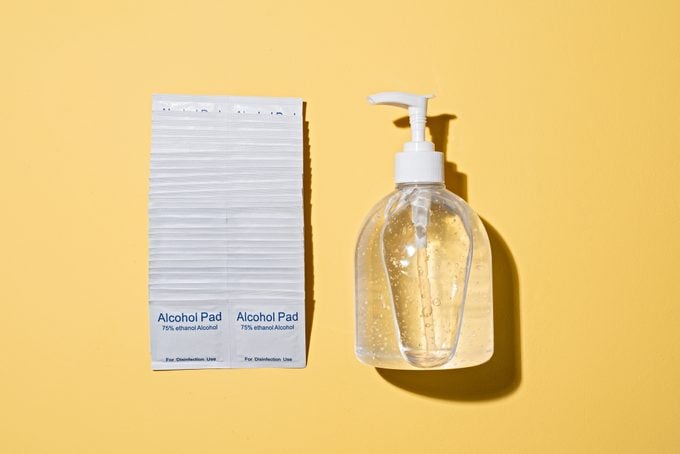
Can you use Clorox wipes on your phone?
In Apple’s guidelines for cleaning iPhones, disinfectants like Clorox wipes are considered safe to use. If you have an Android smartphone, on-the-go Clorox wipes, Lysol wipes and other Lysol products are recommended for sanitizing many electronics, including smartphones and glass-display computer screens.
Wondering how to clean your phone screen without doing major damage? Skip the disinfectant wipes, says Kelso. Instead of using a product with harsh chemicals directly on your screen, stick with his go-to mix of alcohol and water on a microfiber cloth.
If you’re willing to risk damaging your screen by using a Clorox or Lysol wipe directly on it, be sure you at least wring out any excess liquid. Avoid getting liquid in any openings—it could seep into your device and damage it.
Can you use alcohol wipes on your phone?
Alcohol wipes are approved by Apple’s experts for cleaning iPhones. (For the best germ-busting results, the company recommends using alcohol pads with 70% isopropyl or 75% ethyl alcohol.) But as Kelso points out, do you really want to risk using them when they have the potential to ruin your screen with repeated use? Applying an alcohol-and-water solution to a microfiber cloth and wiping your screen with that is a much safer way to clean your phone.
Can you use hand sanitizer on your phone?
Hand sanitizer contains fragrances and rubbing alcohol that could harm your smartphone, so it’s best to avoid using it as a phone disinfectant.
Another thing you’re doing that iPhone experts wouldn’t: using heavy-duty household cleaners, including window cleaners like Windex, hydrogen peroxide or bleach, to clean your device. That’s a big no-no. These products have harsh chemicals that could damage your phone’s screen coating, says Ek. When in doubt, she recommends checking the manufacturer’s instructions for the proper care guidelines.
Can you use wet wipes on your phone?
You should be able to use any antibacterial wipe to clean your phone, whether it’s an Apple or Android device, according to Ek. Just one caveat: Make sure the phone is turned off before you wipe it down, and wait for it to fully dry before turning it on again. That said, Kelso suggests sticking with a microfiber cloth—it won’t damage or scratch your screen.
Can you use Windex on your phone?
Experts unanimously advise against using Windex on your phone. Windex contains ammonia, a harsh chemical that can cause damage to your phone’s touch-screen coating and LCD display over time.
Are there any other products you can use to clean your phone?
Yes. If your phone stays physically clean but you’re worried about its germiness, consider purchasing Phone Soap. This product uses UV radiation to zap the bacteria living on your phone.
“When applying cleaning solutions, sometimes you have to let the wet solution sit on your phone for a few minutes to kill germs,” says Kelso. “With Phone Soap, you can simply place your phone in the device to remove the germs. UV rays will bombard your phone to clean the germs, and Phone Soap will charge your phone as well.”
How often should you clean your phone?
Gerba recommends wiping down your iPhone or Android device with a microfiber cloth every day. If wiping down your phone daily sounds unrealistic, remember just how germy phones can be.
“We have found that the germiest phones are those of teenagers and cooks in restaurants,” Gerba says. But even if you don’t fall into one of those two categories, you’re not in the clear. “Phones are germ mobile devices,” he says. “You are putting germs on the phones and taking them off all day.”
At the very least, you should give your phone a good cleaning twice a week, according to Ek.
How to keep your phone clean
Learning how to clean a phone screen is a good start, but you’ll also want to take steps to keep your phone clean and bacteria free during the day. Our experts offered up some genius tips that anyone can follow.
- Designate a special pocket in your handbag or backpack for your phone, which will keep it separated from other items that might not be fully sanitized.
- When exercising at a gym, stash your phone in a pocket or armband instead of leaving it on workout equipment that could be carrying sweat, hair, skin and other germs from previous users.
- Avoid using your smartphone on public transit or in the bathroom, where harmful bacteria could find its way onto your phone’s surface.
- Rather than cooking with a recipe from your phone, print out the recipe on a piece of paper. Illness-causing bacteria such as E. coli and salmonella from raw poultry, beef, pork and fish can contaminate your device if you leave it in the kitchen while you cook.
- Make sure to wash your hands thoroughly before reaching for your phone, especially if you have been out in public.
Why trust us
At Reader’s Digest, we’re committed to producing high-quality content by writers with expertise and experience in their field in consultation with relevant, qualified experts. For this piece, Brooke Nelson tapped her experience as a seasoned tech reporter and interviewed experts in microbiology and cleaning. Then Burton Kelso, owner of tech-repair company Integral and a technology expert with more than 30 years of experience working with all types of tech devices and gadgets, gave it a rigorous review to ensure that all information is accurate and offers the best possible advice to readers. We relied on reputable primary sources, including Apple, Lysol and academic journals. We verified all facts and data and backed them with credible sourcing, and we will revisit them over time to ensure they remain accurate and up to date. Read more about our team, our contributors and our editorial policies.
Sources:
- Charles Gerba, PhD, professor of microbiology and public health at the University of Arizona; email interview, Dec. 21, 2023
- Jessica Ek, senior director at the American Cleaning Institute; email interview, Dec. 21, 2023
- Burton Kelso, owner and chief technology expert at tech-repair company Integral
- Medicina: “Contamination by Antibiotic-Resistant Bacteria on Cell Phones”
- Scientific Reports: “Mobile phones are hazardous microbial platforms warranting robust public health and biosecurity protocols”
- Apple: “Cleaning your iPhone”
- Lysol: “How to Clean Electronics in Your Home”

